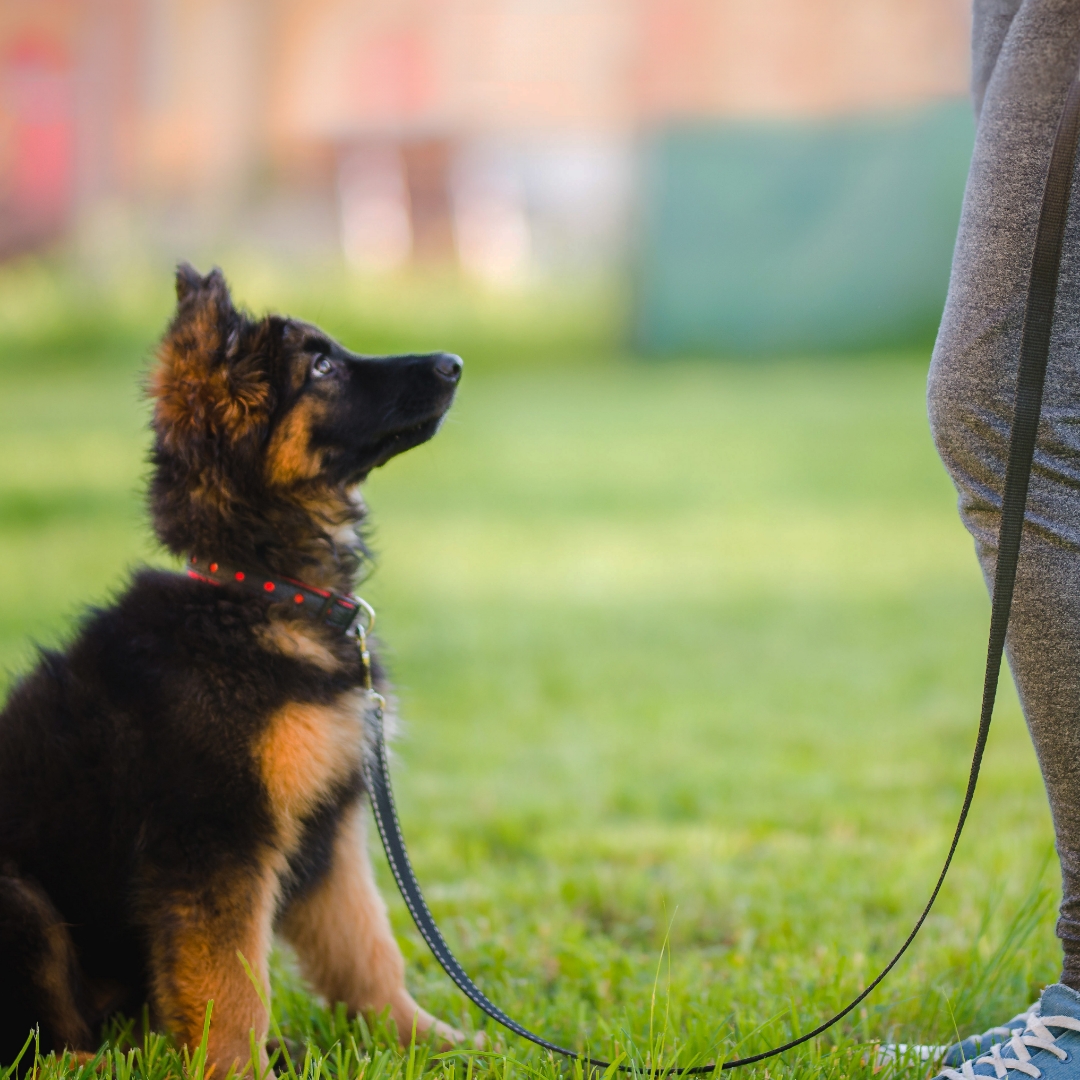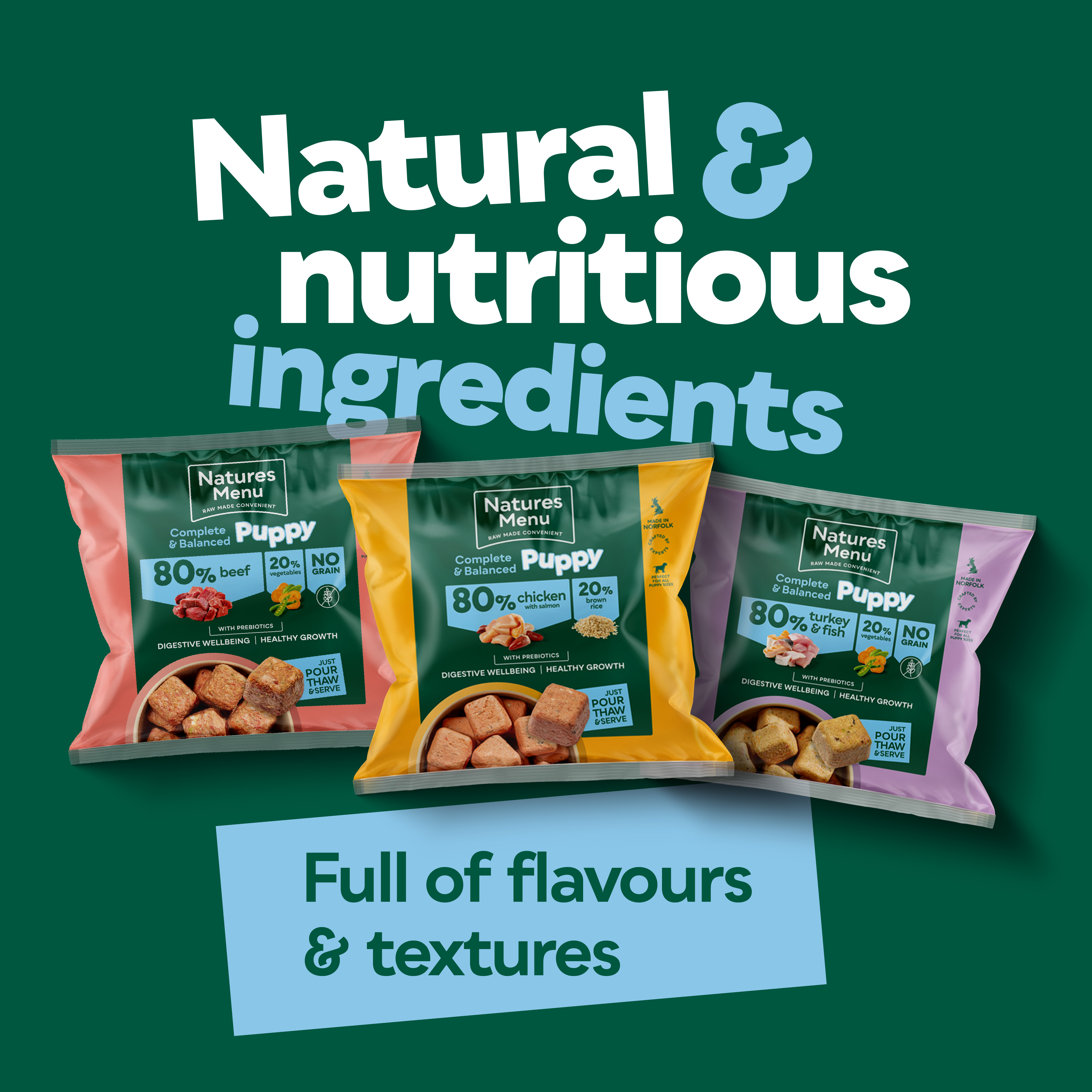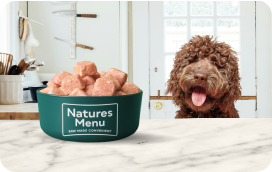HOW TO TRAIN A PUPPY
Table of Contents:
Getting ready for bringing your puppy home
Understanding your puppy’s behaviour
How to train a puppy with positive reinforcement?
Establishing your puppy’s routine
How to toilet train a puppy
Choosing raw food for puppies
The benefits of raw food for puppies
Switching to raw food for puppies
Your puppy food and training FAQs
- Can I give my puppy raw food?
- What’s the best raw food for puppies?
- Can you train a puppy with food?
- What’s the best way to use food to train a puppy?
- How do you toilet train a puppy?
To sum it all up…
Puppy training is lots of fun, and it’s great to get the whole family involved. But there’s no doubt about it, you’ll need plenty of time, patience and treats to get your pup settled in. Which is why we’ve put together this blog – an expert look at how to train a puppy. It’s full of tried-and-trusted tips on everything from how to toilet train a puppy and establishing social skills to rewarding positive behaviour and trying raw food for puppies…
 Getting ready for bringing your puppy home
Getting ready for bringing your puppy home
Before you bring your puppy home, it’s really important to create a comfortable environment, so they can start to feel secure and settled sooner. For many, that means buying a crate – a large pen your puppy can sleep in during the early weeks, rest in when they need some quiet time after puppy training and be safe in when you’re busy. Make it cosy inside and keep the door open during the day to begin with, so your puppy learns it’s a place of haven not a punishment.
If a crate’s not for you, it’s still a good idea to set up a dedicated space for your puppy, whether it’s a comfy dog bed or a playpen, so they’ve got their own space and can start to feel calm and comfortable in your home.
Before you pick up your puppy, ask the breeder to let you know what food they’ve been using – or even to give you some to take with you. That way you can keep your puppy’s food consistent during their first few days with you, so they’ve got some familiarity while they’re settling in.
Once they’re starting to feel at home, you can gradually switch to your choice of food, or try specially made raw food for puppies – more tips on that later on.
Understanding your puppy’s behaviour
We always say that the best way to train a puppy is to start early, being calm and consistent with them right from the word go. But it’s not a one-way street. If you want your puppy to understand you, you need to understand them too – and that starts with the developmental stages they’re going through.
Puppies go through several different developmental stages, from neonatal to juvenile, and each one comes with different behaviours and tendencies. Getting familiar with those stages and behaviours will help you with the best way to train your puppy and the care they need. For example, during the socialisation period, it’s important (and a lot of fun!) to carefully expose your puppy to different environments, people and animals to help them grow up into a happy, well-adjusted, sociable dog. It is also equally important and a great time to learn about what your puppy likes and dislikes too, for example spotting when they are showing signs of fear or nervousness so you can be sure your puppy grows up full of confidence for later years.
How to train a puppy with positive reinforcement?
Whenever we’re asked about how to train a puppy, positive reinforcement is our number one tip, especially when it’s backed up by some really healthy puppy treats. It’s a popular training technique that rewards pleasing behaviour with plenty of enthusiastic praise and bite-sized snacks – and it’s a great way to build a super-strong bond between you and your pup.
Lots of puppy parents find positive reinforcement really works and it’s easy to see why It teaches your puppy that when they display a behaviour you like, such as keeping all four paws on the floor and not jumping up, they get rewards. It’s a huge incentive for them to repeat the behaviour in the future. They’ll love getting lots of praise and attention when they do well, and adding some carefully chosen treats into the mix can make it even more effective.
Our Puppy Chicken Treats are a great option. Made for little mouths and endorsed by Gwen Bailey’s Puppy School, they're 95% meat and come in a resealable, pocket-sized pouch, handy for on-the-go training.
Establishing your puppy’s routine
Getting your puppy into a regular, consistent routine is really important because it helps them feel secure and understand what’s expected of them – which means a happier, more relaxed pup.
So what makes a good puppy routine? Well, feeding and walking them at the same times each day is a great start, as well as setting aside time for play and training. As we’ve just seen, positive reinforcement and healthy puppy food and treats can help to back that up too.
A consistent routine can also be helpful when it comes to everyone’s favourite challenge – how to toilet train a puppy – because it helps them anticipate when it’s time to go outside. Let’s take a look…
How to toilet train a puppy
Potty training can be one of the trickier parts of settling in your puppy, but start early, build in some of our tips and you and your pup will get there sooner than you think.
When toilet training a puppy, remember as a youngster they only have little bladders and need to relieve themselves regularly. After every nap or rest, following play time, feeding and other periods throughout the day, take them outside to their designated toilet area. When there, engage in play to relax them. As a puppy relaxes, their bladder will too! Give gentle praise whilst the action takes place and then lots again and treats afterwards to reinforce the toilet training.
If accidents happen indoors, and they inevitably will from time-to-time, never tell your pup off. This will only encourage them to be nervous about going to the toilet when around you, and it’ll also have no impact on their toilet training. Simply ignore any that do occur and instead focus on heavily praising and celebrating when they go outdoors. Your puppy’s diet can also play a part in their potty training – raw dog food for puppies can sometimes be easier for them to digest , which means they’ll find it easier to poo regularly.
 Choosing raw food for puppies
Choosing raw food for puppies
Every puppy parent wants to make sure their newest family member has tasty dinners they love, packed with all the nutrition they need – and if you ask us, a raw diet is the way to go. Choosing raw food for puppies gives them a great combination of healthy, nutritious and natural ingredients, full of flavours and textures they’ll love exploring. Even better, it might just make training easier too.
Lots find their dogs can concentrate better and focus on training more when they’re fed a natural raw food diet with no added preservatives or sugars. Behaviour and trainability have also been shown to improve when dogs eat a diet that’s rich in omega 3s, which raw meat contains healthy, natural levels of. Even better, as we saw earlier, raw food for puppies and dogs may help them digest their food more efficiently and potentially make their poos regular and firm – a big help when it comes to potty training your new pup.
The benefits of raw food for puppies
Giving your puppy a raw food diet from a young age can be a great choice for lifelong nutrition. Raw meat’s known to be rich in proteins and natural omega 3s, and high-quality raw dog food is free from nasty additives and unnecessary sugars.
We love hearing from happy pet parents who’ve made the switch to raw, and when they’re talking about the benefits they’ve seen, some things come up again and again. Shinier, glossier coats are one we hear a lot, and that’s thanks to all those natural proteins and omega 3s.
We also hear a lot about firmer, less smelly, more pick-up-able poos, because natural foods can be easier to digest and therefore, potentially create less waste. Which makes for happier dog walks, day in, day out.
Switching to raw food for puppies
If you’re thinking of switching your puppy to a raw food diet, we always recommend doing it gradually over a week to get them used to eating something new – and not starting until your puppy’s feeling settled in their new home.
When you and your puppy are ready to make the switch, we’ve put tips and advice into this practical guide to support you in transitioning your dog to a raw food diet.
It’s really important to make sure you’re giving them a balanced diet with all the nutrients they need to grow and develop properly, which is why specially developed raw dog food for puppies, like our dedicated puppy range, can be a big help. It’s also a good idea to chat to your vet about making the switch, so they can give you some personal advice on what your puppy needs, based on their size, age and breed.
Your puppy food and training FAQs
Can I give my puppy raw food?
Absolutely! Raw meat is known to be rich in proteins and natural Omega 3s as well as being free from nasty additives and unnecessary sugars. Once they’re settled at home, we’d recommend switching them gradually over a week to get them used to eating something new.
What’s the best raw food for puppies?
The best raw ingredients for puppies are natural, nutritious and unprocessed. Look out for clear and transparent ingredients, so that you can be sure what you’re feeding. Quality recipes will include high meat content, quality vegetables, and extras to support healthy growth. Meals that are complete + balanced will include everything they need in one meal.
Can you train a puppy with food?
Yes, positive reinforcement using treats is a great way to train your puppy. It helps build a bond between you and your pup. A selection of carefully chosen treats can be a huge incentive for them to repeat good behaviour in the future.
What’s the best way to use food to train a puppy?
Positive reinforcement is our number one puppy training tip. It teaches your puppy that when they display a behaviour you like, they get rewards. Choosing a varied selection will help to keep them engaged and excited when it comes to being rewarded with a tasty treat!
How do you toilet train a puppy?
At important moments throughout the day, such as after naps and rest, feeding times or play, take them outside to their designated toilet area. Make sure they are nice and relaxed so they feel comfortable and happy doing the business. Give plenty of praise afterwards including treats to reinforce the behaviour you want them to do.
To sum it all up…
When you’re weighing up the best way to train a puppy, remember that consistency, routine and positive reinforcement are amazing tools for helping your new arrival feel happy, settled and part of the family. Build in a healthy, balanced diet full of all the nutrients they need and don’t forget to back up your training with some healthy puppy treats to encourage plenty of those behaviours you would like to see repeated.
If you’d like a deeper dive into feeding your puppy a raw diet, we’ve got a handy guide right here too.








 Getting ready for bringing your puppy home
Getting ready for bringing your puppy home Choosing raw food for puppies
Choosing raw food for puppies